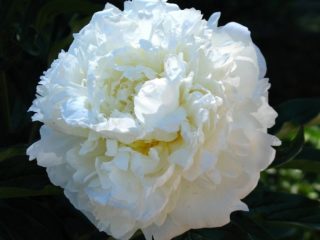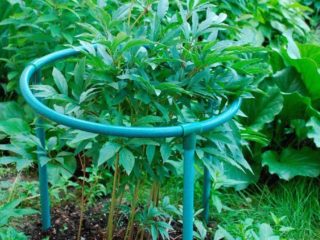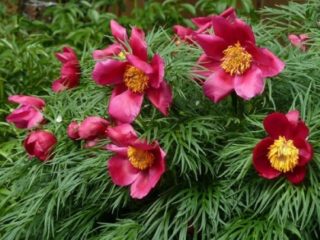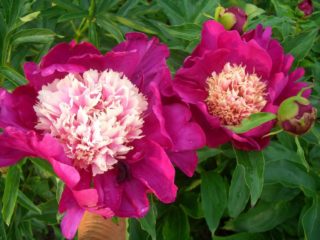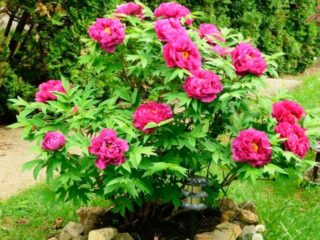Content
Peony Lollipop got its name from the similarity of flowers to sweet candy candies. This culture is an ITO-hybrid, that is, a variety created as a result of crossing the tree and herbal varieties of the peony. The author of the plant is Roger Anderson, who received the first copy in 1999 in California.
Description of Ito-peony Lollipop
Peony Lollipop is a medium-sized plant with straight, almost sprawling stems 80-90 cm high. The leaves are green, glossy, with well-visible veins. On the tops of the shoots - three-lobed, lateral - oblong-oval with a pointed end. The Lollipop peony bush grows at a moderate pace, but the density of shoots in the rhizome area is high, so it requires regular separation (every 3-4 years). The bush does not need supports.
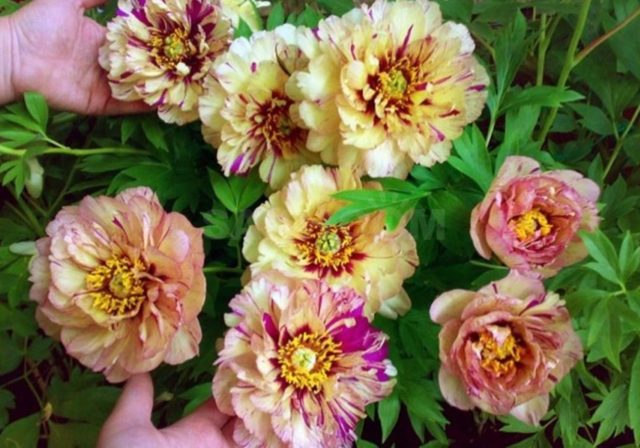
Each stem of a Lollipop peony can bear multiple flowers
The frost resistance of the culture corresponds to the 4th zone. Peony Lollipop easily tolerates frosts down to -35 ° C. It can be grown even in the northern regions, as it develops normally at low temperatures and has an early flowering. Planting in partial shade is acceptable, but the culture feels best in the sun.
Flowering features
By the type of flowering, Lollipop peony belongs to the terry varieties. The flower has a variegated color: yellow petals seem to be covered with strokes of a red-violet hue. Flowering time falls in the third decade of May. The duration is quite long, up to 1.5 months.
The diameter of the flowers is relatively small - rarely which specimens reach 17 cm, usually their size is 14-15 cm. In addition to the central one, several lateral buds can be located on one stem. The aroma is weak but pleasant.
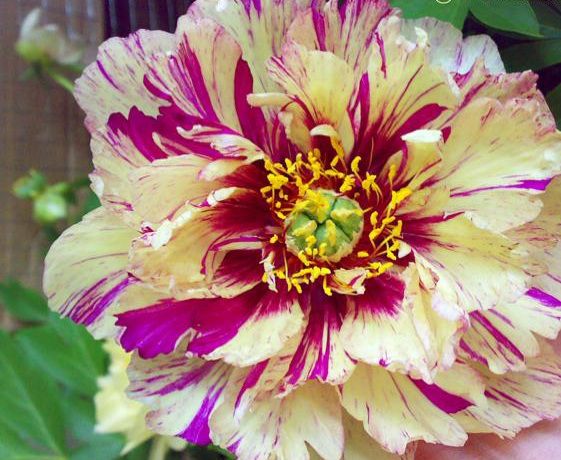
The central part of the flower (with pistils) is greenish, surrounded by a ring of stamens about 15 mm high, their color is yellow
All petals in the middle of the inflorescence and at the edges are terry, there are practically no straight ones.
The flowering intensity depends solely on the light. The more time the Lollipop peony is exposed to sunlight, the larger the diameter will be. In addition, the number of buds depends on this. Unfavorable weather conditions in the form of wind and temperature practically do not affect the flowering intensity.
Application in design
The high density of the bush allows you to use Lollipop peony to decorate various elements of the garden: paths, sidewalks, benches, gazebos, etc. In flower beds, the crop can be used as a centerpiece or to dilute other flowers. They are best combined with plants that have a contrasting shade - bright red or green.
The abundance of relatively large flowers, which almost completely cover the upper part of the bush, always attracts the eye, therefore the Lollipop peony is often used as a single plant.
It grows poorly in containers of limited volume, since it has an extensive root system. Therefore, cultivating it in flowerpots and flower beds with a small amount of land is not rational. It gets along well with poppies, asters, irises and chrysanthemums.
Reproduction methods
Reproduction of the Lollipop peony is standard for this culture, usually one of the following methods is used:
- root cuttings;
- layering of large lateral branches;
- dividing the bush;
- seeds.
Seed propagation is practically not used, since obtaining flowering bushes can take 7-8 years. The timing of obtaining full-fledged plants in other ways is somewhat shorter, but also not fast. So, with the help of cuttings, it is possible to get flowering bushes in 2-3 years, with cuttings 4-5 years.
The only breeding method that guarantees flowering next year is by dividing the bush. Moreover, a peony needs a similar procedure every 3-5 years. It is usually produced at the end of the season, after the seed formation process is complete.
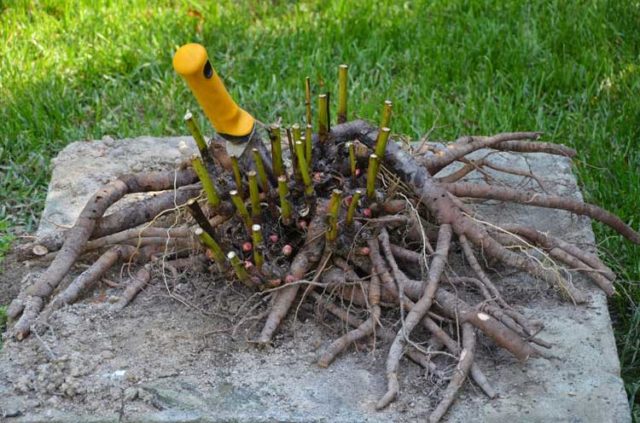
Separation of the Lollipop peony bush is best done with a knife.
After that, it is recommended to completely cut off all the stems of the peony and only then dig out the rhizome, leaving the shoots up to half a meter long. In this case, it is advisable to save them for each of the stems. Separation of the Lollipop peony is carried out using a shovel or a large knife. Then the separated part is planted in a new place.
Landing rules
The soil for cultivation can be of any composition. Only on sandstones the Lollipop peony does not grow very actively, however, the use of dressings can solve this problem. Planting is carried out at the end of the season, immediately after the seed has been received (mainly by dividing the bush).
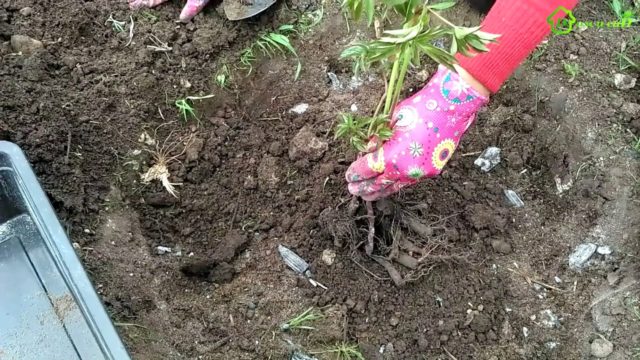
When planting a Lollipop peony, use pits up to 50 cm deep with a diameter of 50-60 cm
It is recommended to lay a drainage layer at the bottom of the planting pit, on top of which compost or humus with a height of 10-15 cm is poured. The height of the soil placed on top of the fertilizer is selected so that the rhizome of the Lollipop peony is completely placed in the pit. Then it is covered with soil and tamped. After that, abundant watering is done.
Follow-up care
Watering is done every 1.5-2 weeks. In case of drought, the break between them is reduced to one. If it rains, the plant need not be watered at all.
Top dressing is performed 4 times per season:
- In early April, nitrogen fertilizers are used in the form of urea.
- At the end of May, phosphorus-potassium mixtures are used. Superphosphate is especially popular.
- After the end of flowering, the plant is fed in the same way as in the previous paragraph.
- At the end of autumn, pre-winter feeding in the form of organic matter is allowed. It is best to use wood ash.
Lollipop peony pruning is performed once a season in preparation for wintering.
Preparing for winter
Peony Lollipop is an extremely hardy crop, capable of withstanding frosts down to -35 ° C without any shelter. At the same time, he is absolutely not afraid of cold winds. Even young specimens are able to withstand harsh winters. Preparation for cold weather consists in cutting the stems of the plant almost to the very root (usually the lowest bud is left on each shoot).
Sometimes, before winter, the Lollipop peony is recommended to be fed with organic matter - compost, humus or wood ash. You can also use mineral dressings, consisting of phosphorus-potassium fertilizers. Their application rates are half of those recommended in summer.
Pests and diseases
Ornamental plants, in particular Lollipop hybrid peonies, are vulnerable to fungal and viral infections. Usually, the damage to plants by diseases occurs as a result of violations of agricultural technology. Powdery mildew and rust are the most common fungal diseases. Viral diseases are represented by various types of mosaics.

The symptomatology of rust is very characteristic - the appearance of brown or black spots on the leaves and stems
The causative agent of the disease is a fungus of the Pucciniales family.If measures are not taken in time, the bush completely discards the foliage and buds within a month, and the plant may die. Treatment consists in removing the affected parts and destroying them. After that, the plant must be treated with a 1% solution of Bordeaux liquid.
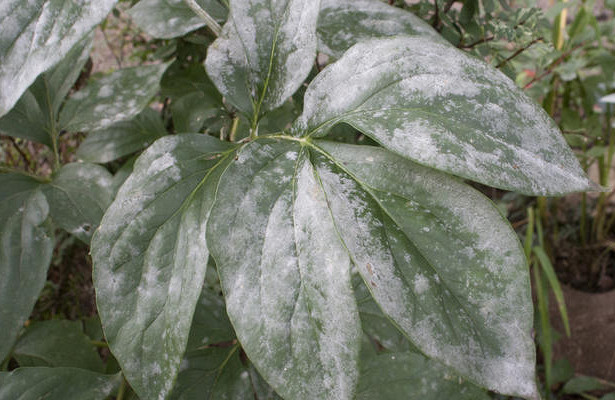
Powdery mildew appears as gray or white patches that grow rapidly
Within a few days, the fungus is able to cover the entire foliage of the affected peony. The plant can exist for a long time in this state, but at the same time there will be no flowering and formation of ovaries.
The use of copper-containing preparations for the treatment of powdery mildew has an average effectiveness: it will be possible to overcome the disease, but it will take too much time. To speed up the process, it is recommended, instead of Bordeaux liquid or copper sulfate, to regularly spray Lollipop peony with a 0.5% sodium carbonate solution or use Figon. The processing frequency is one week, the duration is one month.
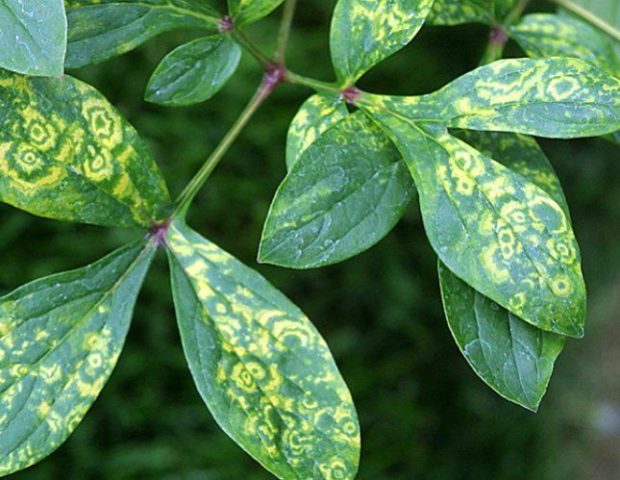
The filtering virus leads to the formation of a mosaic - the appearance of a complex pattern of yellow on the leaves
Most often, the plant is affected by the disease in the second half of July. The mosaic has a focal character, and if it is noticed in time, the peony can still be saved. If the defeat is global, the bush will have to be completely destroyed, since there is no treatment. Leaves with a characteristic color should be removed along with the shoot and burned.
The most dangerous pest of the Lollipop peony is the common aphid, as well as the ants that control its reproduction. Usually these two species are present on the bushes at the same time.

Aphids can cover the stems of Lollipop peony with a solid cover
A large number of small insects suck out the juices of the plant, inhibiting its growth, and the ants breeding it can spread fungal diseases on their paws. Aphids have a fairly high resistance to many drugs, so especially powerful insecticides should be used against it - Actellik, Akarin, Entobacterin. Less toxic drugs (for example, Fitoverm) against many varieties of this pest are practically useless.
Conclusion
Peony Lollipop is a beautiful large-flowered terry hybrid of herbal and woody forms. It is distinguished by a large number of flowers on the bush. The plant is widely used in landscape design due to its variegated and bright appearance. Peony Lollipop is very hardy, can withstand frosts down to -35 ° C, its stems do not break under the weight of large flowers.
Reviews of peony Lollipop

